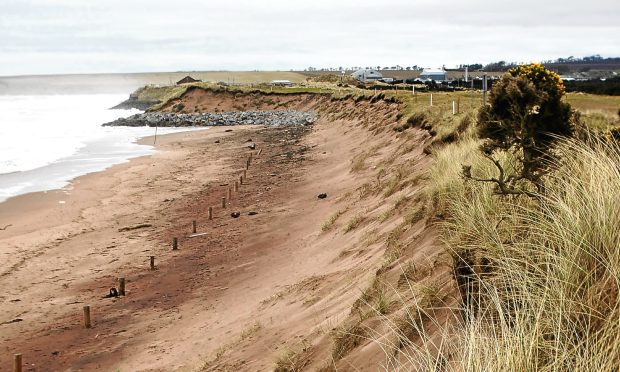I looked back to this time last year to see what I had written about and it confirmed what the Doyenne and I suspected. The weather was milder a year ago but, despite the recent cold snap, signs of spring this year seem at least a fortnight earlier.
There is growth on the shrubs and well-formed buds on the trees but it is the early interest in the nesting boxes in the garden that has caught our attention. As the mornings draw out we watch tree sparrows investigating the boxes from our bedroom window; no sign yet of nesting material being taken in but we’ll be keeping our eyes on the situation.
On Monday evening, out last thing with Inka, my first oystercatcher of the season flew over, saluting us with its familiar kleep, kleep call. Peewits and curlews will soon be following, heading into the glens to nest.
Natural forces
I spent my early, formative years in Montrose and summers were spent on the beach. There were donkey rides and sand castle competitions, a section of the beach was roped off for safe swimming and there were lifeguards, and a beach mission held services for children.
All changed now. The promenade has had to be reinforced with boulders to prevent erosion of the waterfront by the sea. The first, second and third tees of the Medal golf course run alongside the dunes which stretch north from the beach promenade. It has been many years since I walked along those dunes and I was surprised by the erosion which has occurred to this classic links course.
It is the fifth-oldest course in the world, on a par – forgive the pun – with the likes of Royal Dornoch and St Andrews. The game has been played at Montrose since before 1562, when James Melville, the famous cleric and reformer, was taught as a child ‘how to use the glubb for goff’.
Not being a golfer, I wondered why the rock erosion defences had stopped opposite the 2nd tee, as erosion of the dunes at the 3rd tee seems ongoing and damaging to a course of such historical significance.
I’d walked as far as the pipey, an obsolete sewage pipe which discharged sewage straight into the sea and a landmark well known to Montrosians of an age with myself. The sky was pewter grey, the sea lumpy with a heavy surf breaking on the shore. At the top of St Cyrus Beach, to the north, spindrift cast a veil of fine mist over the shore.
Out to sea an oil support vessel and a cargo ship waited for the Montrose pilot to guide them up the approach of the River South Esk to a safe berth in the port. I watched a gull – probably a herring gull, but too far out to identify – being harried by a brown bird of similar size. It looked like an arctic skua up to its tricks of harassing the gull to regurgitate food which the skua then eats.
I associate skuas with the north and west of Scotland and I’m wondering if changes in weather patterns are attracting these birds south.
A family heirloom
A call from Hamish Watt, retired Montrose solicitor, took me into the town to collect my father’s cookery book. It’s strange how things land up in solicitors’ repositories as my father, also a solicitor, would have said.
My parents divorced and my father, who had never lifted a finger in the kitchen, found he had to look after himself. Calling on the experience and help of every housewife he knew, he set about writing his own cookery book. It assumes nothing and is written in the simplest style, reflecting the title Any Idiot Can Cook This Way. There is a recipe for breakfast, lunch and supper for every day of the year; menus for dinners; what to do with left-overs and much else.
Interspersed among the recipes are salutary admonitions: When I eats I sweats and when I wark I dees wi’ cauld, Spread the table and the quarrel will end, Better belly rive than guid meat spill.
The book runs to 191 typed pages and each of our children left home with a copy in their knapsack. It must have set them on the right road because, along with a dash of cookery osmosis from the Doyenne, all are excellent cooks. The book I picked up from Hamish looks to be one of the originals so it is something of a family heirloom. Father had thoughts of getting his cook book published and perhaps now is the time to look into this.
As the mornings get lighter the birdsong starts earlier. It starts around 5.15 with a blackbird’s fluid song, joined with a couple of thrushes and a small choir of garden songbirds. There’s a break for about an hour and the dawn chorus proper starts about 7 o’clock. Across the field, the rooks and the jackdaws tune up and Inka lets us know it’s time for us to get moving.


